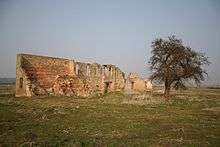Tupholme Abbey
Tupholme Abbey was a Premonstratensian abbey close to the River Witham some 10 1⁄2 miles (16.9 km) east of the city of Lincoln, England. The Witham valley in Lincolnshire is notable for its high concentration of monasteries—there were six on the east bank and three on the west—all presumably drawn to the area by the usefulness of the River Witham for transport and by the wealth (in wool) that it transported.[1] The abbey was destroyed in 1536 during Henry VIII's Dissolution of the Monasteries. The abbey ruin, which is located off the B1190 between Bardney and Horncastle,[2] is a Grade I listed building[3] maintained by Heritage Lincolnshire, and may be visited, free of charge, any day, from dawn until dusk.[4]
| Tupholme Abbey | |
|---|---|
 Ruins of the Abbey | |
| Location | Tupholme, Lincolnshire, England |
| Coordinates | 53°11′56″N 0°17′17″W |
| Founder | Gilbert and Alan de Neville |
| Built | from 1155 to 1165 |
| Original use | Abbey |
| Architectural style(s) | Medieval |
| Governing body | Historic England |
| Owner | Heritage Trust of Lincolnshire |
Listed Building – Grade I | |
| Designated | 25 January 1927 |
History


The name 'Tupholme' means an island where rams were raised. Before the Fens were drained, the site was an island in a marsh. 'Tupp' is a word for male sheep first used in the north of Britain during the Middle Ages, with origins generally given as 'unknown', though it is conceivably related to the Swedish word 'tupp' meaning a male chicken (cock).[5] 'Holme' comes from an old Norse word 'holmr', meaning an island. The name Tupholme reflects the influence of Scandinavian cultures on Lincolnshire during the Danelaw 9th-11th century.
The abbey was founded between 1155 and 1165 by Gilbert and Alan de Neville. An abbot and twelve canons were sent from Newsham Abbey, also in Lincolnshire, to found Tupholme.[4][6][7]
Tupholme was never a prosperous house—in 1347, when the abbey was heavily in debt, an enterprising abbot was accused of "forgery and counterfeiting of coin of the realm", apparently using the proceeds to buy corn and wine, which he sold for a profit. Records of visitations in the later years of the abbey also show some misdemeanours—in 1497 Thomas Pynderwelle was banished to Croxton Abbey in Leicestershire as he had become involved with a local woman called Philippa and fathered her a child. In 1482 the behaviour of the canons had evidently been unruly, as they were forbidden to leave the precincts of the abbey without prior permission, or to sit up drinking after Compline. The penalty for such crimes was to be three days on bread and water.[4]
Tupholme was a small house and was suppressed in the first wave of the Dissolution of the Monasteries, in 1536. The last abbot, John Acaster, was given a pension of £18 and the other canons received £1 each.[7] The site of the abbey, together with the church, bell tower and church yard, was granted to Sir Thomas Heneage of Hainton. Sir Thomas built a grand house, based on the monastic buildings, for his daughter Elizabeth and her husband William Willoughby, 1st Baron Willoughby of Parham. This mansion passed through the Willoughby family until it was sold in 1661 by the Fifth Baron Willoughby and became the property of the Vyner family. Around 1700 the Vyners demolished the Tudor mansion and built a new hall (Tupholme Hall, demolished 1976) nearby. They retained one wall of the medieval abbey/house as an eye-catching ornament in their surrounding parkland.[4]
From the 18th century, a farmyard developed around the site of the remaining wall which developed into a busy farmstead by the start of the 20th century. But by the mid 20th century the site was used only for labourers' housing, and by the 1970s it was empty and derelict. However, Tupholme Abbey was to have one more moment of fame, for in 1972 one of the country's biggest pop festivals, starring Rod Stewart and the Beach Boys (among many others), was held there.[4][8]
In 1988 the site was acquired by Heritage Lincolnshire, and the ruin was repaired and opened to the public.
The surviving monastic ruin at Tupholme comprises a single wall, standing two storeys high, virtually to eaves height. It has small square-headed windows lighting the lower storey which was a vaulted undercroft. The upper floor was the refectory of the abbey and has beautiful lancet windows and a very fine reader's pulpit. The reader's pulpit has clearly been 'prettified', presumably as part of Vyner's landscaping scheme—but thankfully so, as it would not otherwise have survived in such a stone-hungry region.[4]
There is a list of Abbots' names in the Victoria County History.[7]
Geography and ecology
The 'holme' in Tupholme indicates that the abbey once stood on an island in a marsh, the surrounding lands having been wet before the fens were drained for farming. Sheep have (and for thousands of years have had) a big influence on the vegetation at Tupholme, their dung promoting the growth of stinging nettles and thistles. There are several fruiting trees on the grounds, including apple and bullace. The many ponds in the abbey grounds are home to a great deal of wildlife including fine-leaved water dropwort and great crested newt. The nearby Southrey Wood is rich in forest wildlife.
References
- "Account of Witham Valley". Archived from the original on 30 June 2013. Retrieved 20 February 2011.
- "Tupholme Abbey". Retrieved 29 July 2018.
- Historic England. "Tupholme Abbey: a Premonstratensian abbey and post-medieval houses and formal gardens (1017403)". National Heritage List for England. Retrieved 20 October 2016.
- "Heritage Trust page for Tupholme Abbey". Retrieved 3 September 2007.
- An English and Swedish Dictionary
- Historic England. "Tupholme Priory (351367)". PastScape. Retrieved 13 September 2009.
- Page, William, ed. (1906). A History of the County of Lincoln. Victoria County History. 2. pp. 206–207 'Houses of Premonstratensian canons: The abbey of Tupholme'. Retrieved 20 February 2011.
- "Community record of pop festivals".
| Wikimedia Commons has media related to Tupholme Abbey. |

